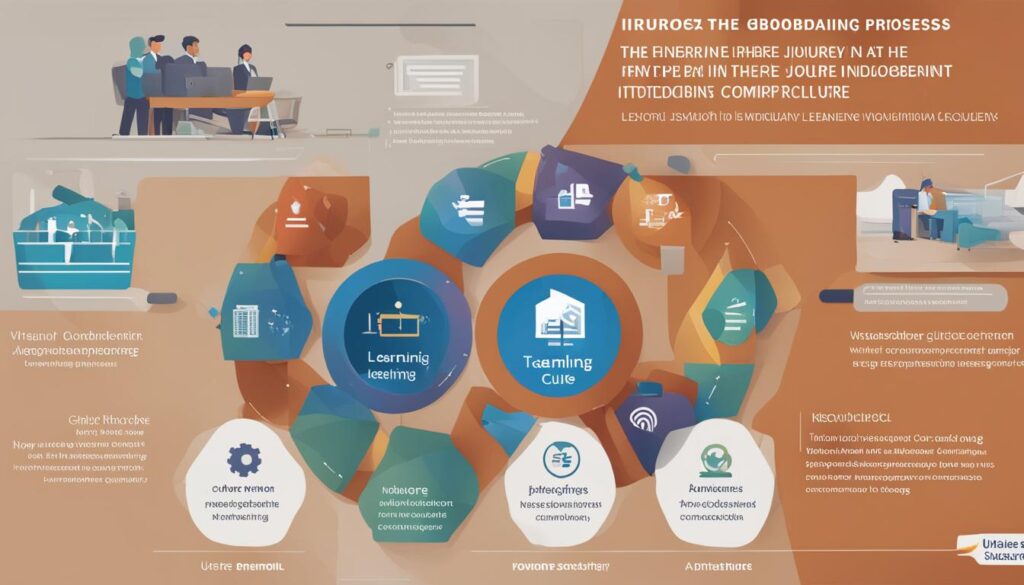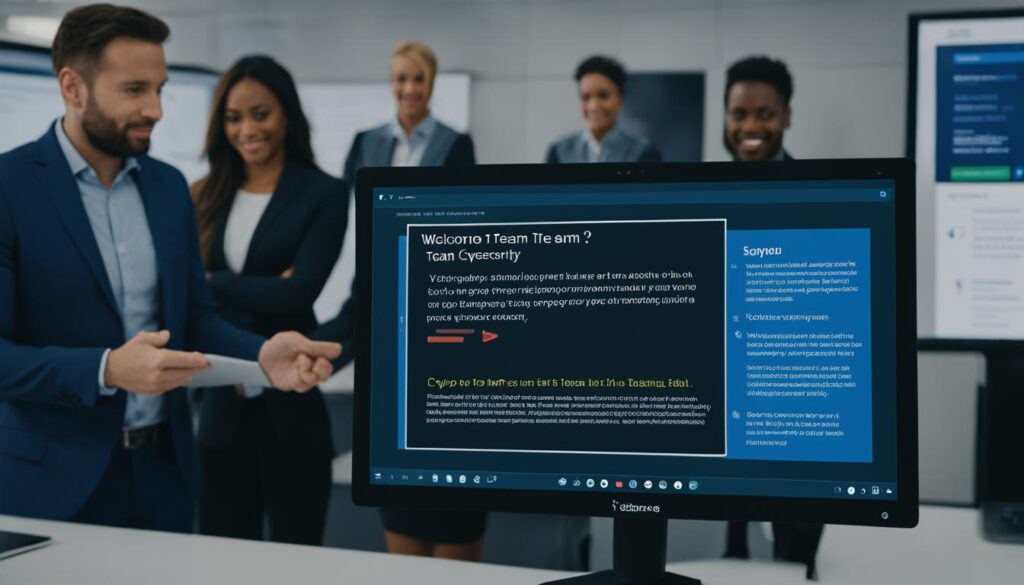When welcoming a new employee into your organization, it’s important to provide them with a smooth transition and set them up for success. This is where the employee onboarding process comes in. Worker onboarding is the comprehensive procedure of familiarizing a new hire with your company from the moment they accept an offer until they become a productive member of your team. It involves much more than simply showing them to their desk.
Employee onboarding includes tasks such as providing detailed information about your organization’s policies and benefits, completing necessary paperwork, and ensuring the employee understands their role and responsibilities. It’s a key process that establishes the foundation for their success within your organization.
Key Takeaways:
- Worker onboarding is the process of familiarizing a new hire with the organization.
- It includes providing comprehensive information about policies and benefits.
- Completing necessary paperwork is an essential part of the onboarding process.
- Effective onboarding ensures that the employee understands their role and responsibilities.
- Employee onboarding sets the foundation for success and engagement within the organization.
The Importance of Employee Onboarding
Research shows that effective onboarding is crucial for organizations to retain new employees and maximize their potential. With the hiring process being both time-consuming and expensive, it is essential to implement onboarding best practices to ensure a smooth transition and increase employee satisfaction.
A well-designed onboarding program enables new employees to become valuable contributors quickly. It goes beyond simply familiarizing them with company policies and procedures. It involves providing comprehensive training and orientation to help them understand their roles, performance expectations, and team culture.
Onboarding is not solely the responsibility of the HR department. The immediate manager plays a vital role in guiding the new employee through the onboarding process. By establishing a strong connection, the manager can help the employee feel valued and supported from day one.
Additionally, onboarding is not limited to new hires. It also applies to employees who are transitioning into new roles within the organization. Effective onboarding strategies ensure that these individuals have the necessary support and resources to succeed in their new positions.
By prioritizing employee training and orientation, organizations can foster a positive and engaging onboarding experience. This sets the foundation for long-term employee satisfaction and contributes to higher retention rates. Implementing onboarding best practices leads to a more efficient and successful workforce, ultimately driving organizational growth and success.
The Onboarding Process
The employee onboarding process is a multi-step journey that begins as soon as a new employee joins the organization. This process encompasses several essential elements to ensure a smooth integration and successful employee onboarding experience.
Step 1: Providing Comprehensive Information
To kickstart the onboarding process, it is crucial to equip new employees with all the necessary information about organizational policies, guidelines, and benefits. This includes details about company culture, mission and vision, dress code, code of conduct, and any other relevant information that will help them navigate their role within the organization effectively.
Step 2: Completing Necessary Paperwork
Compliance is an integral part of the onboarding process. New hires are required to complete essential paperwork, such as tax forms, employment contracts, and confidentiality agreements. This ensures legal and organizational compliance while protecting both the employee and the company.
Step 3: Equipping Employees with Tools and Resources
Successful onboarding requires providing new hires with the tools and resources they need to perform their job effectively. This includes setting up their workstation, providing access to necessary software and systems, and any training materials or manuals that are essential for their role.

Step 4: Communication with the Immediate Manager
The immediate manager plays a vital role in the onboarding process. It is their responsibility to effectively communicate the employee’s role, tasks, and collaboration expectations. The manager should provide clear guidance, answer any questions, and ensure that the employee feels supported and understood from day one.
Step 5: Training and Orientation
Training and orientation are crucial components of the onboarding process. The manager, along with the support of employee onboarding software, facilitates the training sessions and ensures that new employees are equipped with the necessary skills and knowledge to succeed in their role. This includes familiarizing them with company processes, protocols, and any specific job-related training.
Step 6: Assimilating into the Organizational Culture
Integration into the company culture is essential for a successful onboarding experience. Encouraging social relationships among colleagues and introducing new hires to the existing team helps foster a sense of belonging and inclusivity from the start. This can be done through team-building activities, introduction sessions, and providing opportunities for new employees to connect with their colleagues.
To ensure a consistent and streamlined onboarding experience, many organizations use onboarding templates and checklists. These tools serve as guides, outlining the necessary steps and providing a standardized approach for managers to follow when onboarding new employees.
The onboarding process sets the stage for the employee’s entire journey within the organization. By investing time and effort into employee integration, organizations can create a solid foundation for new employee success, fostering engagement, and building long-term relationships.
Best Practices for Employee Onboarding
To enhance the onboarding experience, it is recommended to automate certain onboarding tasks using software solutions like Bamboo HR. Automation streamlines the process and allows new employees to familiarize themselves with their team members before joining the organization.

Personalization is also crucial for creating a positive onboarding experience, as employees feel more engaged when their unique needs and goals are considered. By tailoring the onboarding process to meet individual preferences and providing resources that align with their skillsets, employees will feel valued and motivated from the start.
Moreover, a well-executed onboarding experience should be closely linked to employee engagement and retention. Companies that prioritize the onboarding process are more likely to see higher levels of employee satisfaction, which in turn increases the likelihood of long-term commitment.
To ensure a successful onboarding experience, organizations should:
- Provide a clear and structured onboarding plan with key milestones and objectives
- Assign a dedicated onboarding mentor or buddy to support new employees
- Facilitate introductions and foster social connections within the team
- Encourage open communication and feedback during the onboarding process
- Offer opportunities for ongoing training, professional development, and growth
By implementing automation and personalization strategies while focusing on employee engagement and retention, companies can create a seamless onboarding experience that sets the stage for long-term success and productivity.
Conclusion
Employee onboarding is an essential process for organizations to ensure the success and satisfaction of their new employees. By implementing onboarding best practices, such as providing comprehensive information, effective training and orientation, and fostering a supportive culture, organizations can create a positive onboarding experience that leads to improved employee retention, engagement, and productivity.
One of the key ways to enhance the onboarding process is by leveraging automation and personalization. By utilizing software solutions like Bamboo HR, organizations can automate certain onboarding tasks, streamline the process, and allow new employees to connect with their team members even before joining the organization. Personalization is also crucial, as it makes individuals feel valued and engaged, contributing to a positive onboarding experience.
By prioritizing worker onboarding and following best practices, organizations can set their new employees up for success from day one. The onboarding process should not be seen as a one-time event, but rather as an ongoing journey of integration and growth. By continuously assessing and improving the onboarding process, organizations can ensure that new employees feel welcomed, equipped, and supported as they embark on their new roles.
FAQ
What is employee onboarding?
Employee onboarding is the process of familiarizing a new employee with the organization from the moment they accept an offer until they become a productive member. It involves providing comprehensive information about policies and benefits, completing necessary paperwork, and ensuring the employee understands their role and responsibilities.
Why is employee onboarding important?
Effective onboarding is crucial for employee retention and engagement, as it sets the foundation for success within the organization. Research shows that hiring is time-consuming and expensive, making it necessary to onboard new employees optimally to retain them. A well-designed onboarding program increases the likelihood of employees becoming valuable contributors quickly.
What is involved in the onboarding process?
The onboarding process includes providing comprehensive information about policies and benefits, completing necessary paperwork for compliance, and equipping the employee with the tools they need to perform their job. The immediate manager plays a crucial role in communicating the employee’s role, tasks, and collaboration expectations. Training and orientation are also integral parts of the onboarding process.
What are the best practices for employee onboarding?
To enhance the onboarding experience, it is recommended to automate certain onboarding tasks using software solutions like Bamboo HR. Automation streamlines the process and allows new employees to familiarize themselves with their team members before joining the organization. Personalization is also crucial for creating a positive onboarding experience, as employees feel more engaged when their unique needs and goals are considered. Moreover, the onboarding process should be closely linked to employee engagement and retention, as a positive onboarding experience enhances employee satisfaction and increases the likelihood of long-term commitment.
What is the significance of employee integration?
Assimilating employees into the organization’s culture and encouraging social relationships among colleagues is important for a successful onboarding experience. By fostering a supportive and inclusive culture, organizations can help new employees feel welcome and connected to the team, which in turn improves engagement and productivity.




